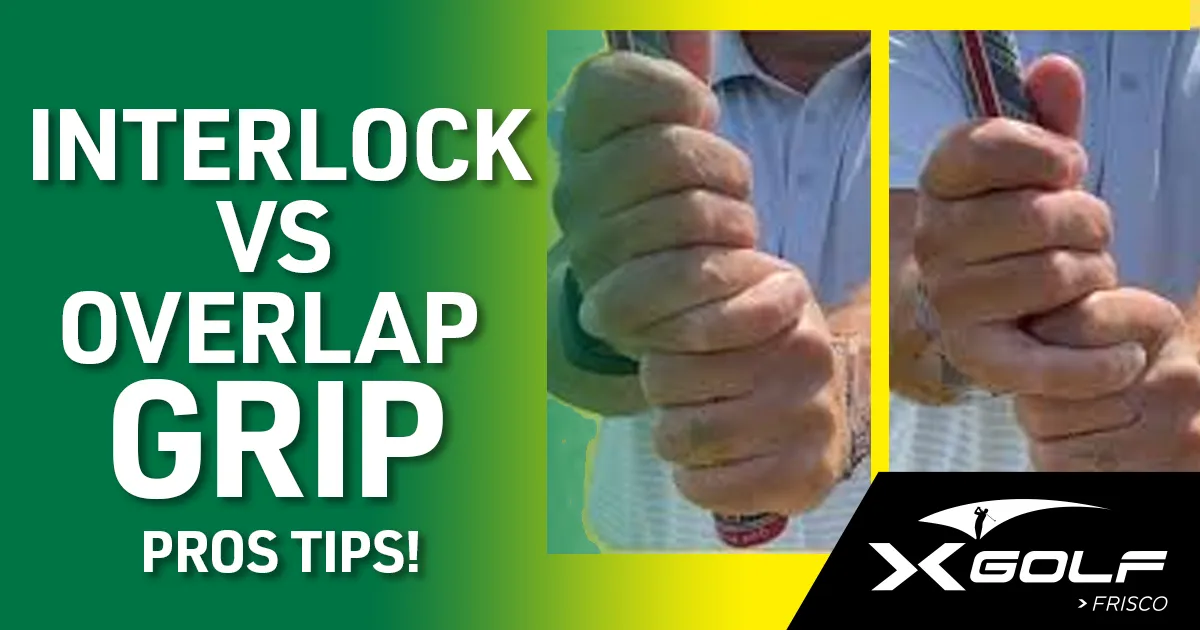
Most golfers use one of two grip styles: the overlap grip or the interlock grip. Both work well, but the best choice depends on your hand size, grip strength, and personal comfort with the connection method.
Understanding Golf Grip Fundamentals
A proper golf grip forms the foundation of every consistent golf swing. Professional instructors emphasize that fundamentals like grip, posture, and alignment are like the foundation of a house – without solid basics, everything else crumbles.
The grip determines how the clubface returns to the ball at impact. Your left hand (for right-handed golfers) sits on top, with your right hand below it. The club should rest primarily in your fingers, not in your palms, allowing for proper wrist hinge and release through the swing.
According to Golf Digest’s PGA Championship analysis, more than 60 percent of American tour professionals use the interlocking grip, contrary to conventional wisdom that suggested the overlap was more popular among professionals.
The Overlap Grip Explained
The overlap grip, also called the Vardon grip after British golfer Harry Vardon, places your right pinky finger over the gap between your left index and middle fingers. Your hands connect without interlocking any fingers.
Professional instructors note that the overlap grip works well for golfers with larger hands, as it provides connection while allowing more independent finger movement.
Here’s how to form an overlap grip:
- Place your left hand on the club first, with the grip resting across the base of your fingers
- Position your right hand below your left, with your right pinky resting on top of your left index finger
- Wrap your right fingers around the club, ensuring both thumbs point down the shaft
Notable professional golfers who use the overlap grip include Arnold Palmer, Phil Mickelson, and Ben Hogan. The overlap grip allows for good hand unity while maintaining wrist freedom, which can be beneficial for generating power and creating different ball flights.
The Interlock Grip Breakdown
The interlock grip connects your hands by weaving your right pinky finger between your left index and middle fingers. This creates a tighter mechanical connection between your hands.
Tiger Woods and Rory McIlroy both use the interlock grip, with research showing it’s more popular among tour professionals than many realize.
To form an interlock grip:
- Start with your left hand positioned normally on the club, grip resting in your fingers
- Place your right pinky between your left index and middle fingers
- Interlock these fingers together, then wrap your remaining right-hand fingers around the club
Jack Nicklaus preferred the interlock because he had wide palms and short fingers, feeling it helped unify his hands throughout the swing.
Comparing Performance Benefits
Biomechanical Differences
Research published in the Journal of Sports Medicine found no significant differences in forearm muscle activity between grip styles, but noted that grip size affects clubhead speed more than grip style itself.
The interlock grip creates maximum hand unity throughout the swing by forming a stronger connection between the hands. This can help golfers who struggle with clubface control by preventing independent hand action during the swing.
The overlap grip allows slightly more independent wrist action, which can benefit golfers who need to create specific ball flights or have naturally strong grip pressure.
Control and Power Factors
Electromyographic analysis shows that amateur golfers produced significantly greater forearm muscle activity with all grip styles compared to professionals, suggesting that learning proper grip pressure is more important than grip choice.
Modern launch monitor data confirms that grip choice affects ball flight patterns: tighter connections like interlock can help golfers who hook the ball, while looser connections can help those who slice.
Choosing Your Ideal Grip Style
Hand Size Guidelines
Professional club fitters use specific hand measurements from wrist crease to middle finger tip to determine grip suitability:
- Less than 7 inches: Interlock grip typically provides better control
- 7-8 inches: Either grip style can work effectively
- More than 8 inches: Overlap grip usually feels more natural
However, recent grip sizing research shows that hand strength and pressure control matter more than raw hand measurements.
Swing Characteristics and Pressure Control
Golf Digest Top 50 instructor Tony Ruggiero notes that golfers with longer fingers gravitate toward overlap grips because interlocking can cause the pinky to wrap around awkwardly.
Consider your natural grip pressure tendencies. If you tend to grip the club tightly, the interlock may help you maintain control with lighter pressure. If you have naturally light grip pressure, the overlap might provide better balance of control and freedom.
Grip Pressure and Feel
Proper grip pressure is measured on a scale of 1-10, with optimal pressure ranging from 4-6. Research on grip pressure distribution shows that consistency matters more than absolute pressure.
Most swing faults related to grip stem from excessive tension rather than grip style choice. Practice swinging with different pressure levels to find your optimal balance between control and freedom.
Common pressure checkpoints:
- Setup: Light but secure (4-5 on the scale)
- Backswing: Maintain consistent pressure
- Downswing: Slight increase for control (5-6)
- Follow-through: Return to light pressure
Making the Grip Change
Transition Timeline and Expectations
Expect 3-6 weeks to fully adjust to a new grip style. Sports research on grip training shows significant reduction in grip-related swing faults with regular practice sessions.
The adjustment period varies by individual, but most golfers see noticeable improvement within 5-7 practice sessions when making grip changes.
Practice Recommendations
Professional instructors recommend this progression:
- Week 1-2: Practice grip placement without swinging – focus on muscle memory
- Week 3-4: Short chips and pitches only – build confidence with new feel
- Week 5-6: Gradually progress to full swings – integrate new grip completely
Practice techniques that accelerate adaptation:
- Use a grip trainer or teaching grip on a practice club
- Practice grip placement while watching TV
- Take slow-motion swings focusing only on grip feel
- Work with a mirror to check hand positions
Troubleshooting Common Grip Problems
Ball Flight Diagnosis
Your grip directly influences ball flight patterns. Here’s how to diagnose grip-related issues:
Consistent slicing: Often indicates grip is too weak or hands aren’t working together effectively (consider interlock for better hand unity)
Unexpected hooks: Usually caused by overly strong grip or too much hand action through impact (overlap might provide better control)
Loss of distance: Research confirms this relates to excessive grip pressure rather than grip style
Inconsistent contact: Generally indicates grip size issues rather than style problems – consider professional grip fitting
Equipment Considerations
Grip size affects performance more than style choice. Professional club fitters emphasize proper grip sizing to ensure optimal hand positioning.
Signs you need grip size adjustment:
- Glove wearing through the heel pad
- Fingers either not touching or digging into the heel pad
- Difficulty maintaining consistent grip pressure
- Hand fatigue during longer practice sessions
Expert Recommendations
Choose the interlock grip if you have smaller hands, struggle with grip consistency, or need maximum hand connection to control clubface rotation. This grip locks hands together for unified action throughout the swing.
Select the overlap grip if you have larger hands, prefer more natural wrist action, or want the grip style that allows for individual finger freedom while maintaining connection.
Golf Digest’s grip analysis notes: “There’s no real science as to who should use what grip,” but general patterns do emerge based on physical characteristics and personal preference.
Remember that grip pressure and size matter more than style for most golfers. The right grip size combined with proper pressure can influence ball flight more than the connection method itself.
Ready to optimize your grip for better golf? Visit X-Golf Rockwall for a comprehensive grip analysis using our advanced simulators and TrackMan technology. Our PGA professionals can measure your swing characteristics and recommend the optimal grip style and size for your game.
Book your tee time today and discover which grip will help you hit more consistent shots. Our professional instruction includes grip analysis as part of every lesson, ensuring you build the proper foundation for long-term improvement.
Frequently Asked Questions
How long does it take to get comfortable with a new grip?
Research shows most golfers see measurable improvement within 5-7 practice sessions, with full adaptation taking 3-6 weeks of consistent practice.
Can I switch between grip styles for different shots?
No – consistency is crucial for developing muscle memory. Use one grip style for all full shots from driver through wedges. Many golfers use different putting grips, but maintain consistency in their full swing grip.
Should grip choice be different for left-handed golfers?
The same principles apply to left-handed golfers, just mirrored. Hand size, grip strength, and personal preference remain the primary factors in choosing between overlap and interlock styles.
When should I consider changing my grip?
Consider a grip change if you’re experiencing consistent ball flight issues, grip-related hand fatigue, or if your current grip doesn’t match your hand size. Always consult with a PGA professional before making significant grip changes.


